Spelthorne St Mary
Coldharbour Lane, Thorpe, Surrey TW20 8TE
Medical
dates:
Medical
character:
Inebriates (female)
In the second half of the 19th
century Miss Antrobus, a regular prison visitor at Westminster Prison,
had been deeply disturbed by the "evil result of short sentences given
in Police Courts to persons charged with inebriety". Formerly,
the proportion of the sexes in the criminal classes was 7 men to 1
woman but, with the increase in female intemperance, this had increased
to 2 men to 1 woman (in Liverpool and London the women sometimes
exceeded the men in drunkenness). In 1878 some 15,357 women were
committed for drunkenness, one woman paying upwards of £200 in
fines.
In 1878 Miss Antrobus acquired a large property with 4 acres of grounds at Bedfont, near Feltham, Middlesex. Her intention was to establish an institution "for the Reformation of women who have fallen in Habits of Intemperance by misuse of Drugs or Alcohol". This would provide inebriate women the chance of overcoming their chaotic alcoholic lifestyles.
The Spelthorne Sanatorium opened on 1st January 1879 with 20 beds. It was licensed under the Inebriates Act, 1878, for the "treatment, physical, moral, and spiritual, of women who have given way to Intemperance by misuse of drugs or alcohol". It was intended primarily for the upper and middle classes; workhouse and penitentiary cases were excluded. The house was convenient and comfortable, with a large garden. There was a chapel attached to the house, where daily services were held.
Patients had to provide their own underwear, boots and shoes, and a dark blue or black dress. They were not allowed intoxicating drinks and had to surrender all money and keys. They were not allowed to go unattended beyond the premises without permission.
The weekly charge, payable in advance, was 12s 6d (62p). Special arrangements were made for a limited number of good laundry workers at a lower rate. A few women who required superior accommodation were received at a charge of 1 to 3 guineas (£1.05 to £3.15) a week. All patients were obliged to stay for not less than one year.
The women were employed in laundry work and needlework.
During 1881 the Sanatorium received over 100 applications for admittance. Of these, 20 were for men, 20 for penitentiary cases, 10 were for more or less insane, 4 were clergymen's wives, 10 were aged women and the rest ineligible for various reasons.
After discharge from the Sanatorium 14 patients had done well, but it was felt that only a year spent at the Sanatorium was too short. Most of the inmates had been drinking for years and the problem was longstanding and deep-rooted; a year was too short a time to effect a radical constitutional change and to acquire a more moral and religious habit of mind.
When Miss Antrobus died in 1882, the institution was taken over by the Anglican Community of St Mary the Virgin (Wantage).
By 1884 it had been renamed Spelthorne S. Mary and S. Bridget's.
By 1894 the institution had 24 beds. In due course it took over the neighbouring Middlesex Industrial School for Girls.
In 1899 it did not renew its license to receive inebriates under the Act. Prison, workhouse or penitentiary cases were therefore not eligible for admission (although they had always been excluded!)
On 28th May 1908 the license was renewed for 10 females. The bed complement was for 34 women, who stayed on average for 13 months.
By 1926 the institution was known as Spelthorne S. Mary. It was fully occupied. Patients were still not allowed to leave the premises without permission, but expeditions were arranged to the countryside for blackberry picking, and to the nearby town. Former patients would visit and spend holiday and festive times with the nuns.
For entertainment and occupation, varied lectures were held, or solo and part singers performed. Patients did handicrafts, including raffia-, leather- and barbola-work.
Patients were still obligated to stay for at least a year. If aged over 50, special leave had to be obtained. All possessions - money, keys and jewellery - had to be surrendered on admission.
Gentlewomen paid from 2 to 3 guineas (£2.10 to £3.15) a week, while middle-class women paid between 15 shillings (75p) and £1. For those admitted under the Act, there was a 1 guinea (£1.05) entrance fee.
In the 1930s the institution moved to a large mansion in Thorpe, Surrey. It was renamed Spelthorne St. Mary.
The mansion stood in 22 acres of land, providing space for gardens, outdoor games and poultry and bee-keeping. The parish church adjoined the grounds, but there was also a chapel within the institution. The patients were encouraged to keep busy with sewing, weaving or rug-making in the Handicrafts Room, or to do housework, gardening, poultry work or bee-keeping.
In 1956 there were 64 beds.
In 1958 the institution had 66 beds. Female drug and alcohol addicts up to the age of 65 years were admitted. The average weekly cost for each patient was £5 18s 7d (£5.93), compared to £4 19s 7d (£4.98) in 1957. In 1959 it was £5 12s 10d (£5.64). The staff consisted of 14 Sisters, one of whom was qualified as a doctor and 3 were trained nurses, and a number of lay workers. No salaries were drawn.
In 1960 the average weekly cost for each patients was £5 10s 2d (£5.51). Private rooms were charged at 7 gns (£7.35), while cubicles and double rooms cost 4 gns (£4.20) for those who helped in the house. The bed complement was 68, with an average occupancy of 60. Most patients (57%) came from London, referred by the LCC or other local authorities. Their average stay was from 6 to 9 months.
In 1960 a ward kitchen was opened to serve the 20 or more patients in bed (new patients were made to stay in bed initially), who otherwise had to have their meals sent up from the main kitchen.
By 1968 all inebriate reformatories in England had closed, except Spelthorne St. Mary.
In 1974 the institution moved to Harpenden, Hertfordshire.
In 1878 Miss Antrobus acquired a large property with 4 acres of grounds at Bedfont, near Feltham, Middlesex. Her intention was to establish an institution "for the Reformation of women who have fallen in Habits of Intemperance by misuse of Drugs or Alcohol". This would provide inebriate women the chance of overcoming their chaotic alcoholic lifestyles.
The Spelthorne Sanatorium opened on 1st January 1879 with 20 beds. It was licensed under the Inebriates Act, 1878, for the "treatment, physical, moral, and spiritual, of women who have given way to Intemperance by misuse of drugs or alcohol". It was intended primarily for the upper and middle classes; workhouse and penitentiary cases were excluded. The house was convenient and comfortable, with a large garden. There was a chapel attached to the house, where daily services were held.
Patients had to provide their own underwear, boots and shoes, and a dark blue or black dress. They were not allowed intoxicating drinks and had to surrender all money and keys. They were not allowed to go unattended beyond the premises without permission.
The weekly charge, payable in advance, was 12s 6d (62p). Special arrangements were made for a limited number of good laundry workers at a lower rate. A few women who required superior accommodation were received at a charge of 1 to 3 guineas (£1.05 to £3.15) a week. All patients were obliged to stay for not less than one year.
The women were employed in laundry work and needlework.
During 1881 the Sanatorium received over 100 applications for admittance. Of these, 20 were for men, 20 for penitentiary cases, 10 were for more or less insane, 4 were clergymen's wives, 10 were aged women and the rest ineligible for various reasons.
After discharge from the Sanatorium 14 patients had done well, but it was felt that only a year spent at the Sanatorium was too short. Most of the inmates had been drinking for years and the problem was longstanding and deep-rooted; a year was too short a time to effect a radical constitutional change and to acquire a more moral and religious habit of mind.
When Miss Antrobus died in 1882, the institution was taken over by the Anglican Community of St Mary the Virgin (Wantage).
By 1884 it had been renamed Spelthorne S. Mary and S. Bridget's.
By 1894 the institution had 24 beds. In due course it took over the neighbouring Middlesex Industrial School for Girls.
In 1899 it did not renew its license to receive inebriates under the Act. Prison, workhouse or penitentiary cases were therefore not eligible for admission (although they had always been excluded!)
On 28th May 1908 the license was renewed for 10 females. The bed complement was for 34 women, who stayed on average for 13 months.
By 1926 the institution was known as Spelthorne S. Mary. It was fully occupied. Patients were still not allowed to leave the premises without permission, but expeditions were arranged to the countryside for blackberry picking, and to the nearby town. Former patients would visit and spend holiday and festive times with the nuns.
For entertainment and occupation, varied lectures were held, or solo and part singers performed. Patients did handicrafts, including raffia-, leather- and barbola-work.
Patients were still obligated to stay for at least a year. If aged over 50, special leave had to be obtained. All possessions - money, keys and jewellery - had to be surrendered on admission.
Gentlewomen paid from 2 to 3 guineas (£2.10 to £3.15) a week, while middle-class women paid between 15 shillings (75p) and £1. For those admitted under the Act, there was a 1 guinea (£1.05) entrance fee.
In the 1930s the institution moved to a large mansion in Thorpe, Surrey. It was renamed Spelthorne St. Mary.
The mansion stood in 22 acres of land, providing space for gardens, outdoor games and poultry and bee-keeping. The parish church adjoined the grounds, but there was also a chapel within the institution. The patients were encouraged to keep busy with sewing, weaving or rug-making in the Handicrafts Room, or to do housework, gardening, poultry work or bee-keeping.
In 1956 there were 64 beds.
In 1958 the institution had 66 beds. Female drug and alcohol addicts up to the age of 65 years were admitted. The average weekly cost for each patient was £5 18s 7d (£5.93), compared to £4 19s 7d (£4.98) in 1957. In 1959 it was £5 12s 10d (£5.64). The staff consisted of 14 Sisters, one of whom was qualified as a doctor and 3 were trained nurses, and a number of lay workers. No salaries were drawn.
In 1960 the average weekly cost for each patients was £5 10s 2d (£5.51). Private rooms were charged at 7 gns (£7.35), while cubicles and double rooms cost 4 gns (£4.20) for those who helped in the house. The bed complement was 68, with an average occupancy of 60. Most patients (57%) came from London, referred by the LCC or other local authorities. Their average stay was from 6 to 9 months.
In 1960 a ward kitchen was opened to serve the 20 or more patients in bed (new patients were made to stay in bed initially), who otherwise had to have their meals sent up from the main kitchen.
By 1968 all inebriate reformatories in England had closed, except Spelthorne St. Mary.
In 1974 the institution moved to Harpenden, Hertfordshire.
Present status (January 2020)
Holmfield at No. 55 Milton Road, Harpenden, had been converted into a hostel for women alcoholics. It was renamed Spelthorne St Mary. It is unclear when it closed but, in 1993, the building was bought by Rothamsted and became a hostel for students and their families. It was renamed Lawes Court.
The first site of the institution had been redeveloped long ago into housing. Only the lodge survives, as does the lodge of the Girls' Industrial School.
The second site in Thorpe has become TASIS The American School in England.
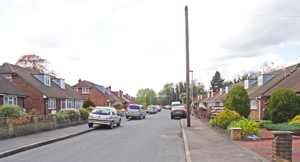
The area around the first site in Feltham was redeveloped for housing in the 1960s. The institution was located at what is now the west end of Mill Way (above) and behind Staines Road (below).
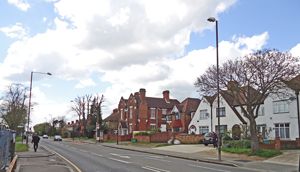
NB Photographs obtained in December 2019
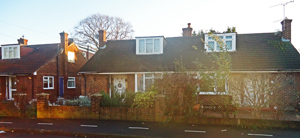
No. 29 Mill Lane is the approximate site of the main building.

The surviving lodge at No. 64 Staines Road.
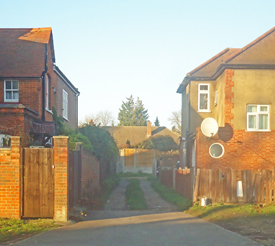
The original main driveway is beside the lodge.
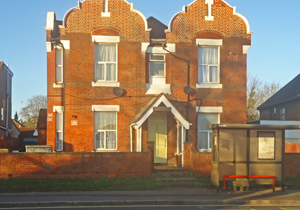
The original lodge for the Middlesex Industrial School for Girls at No. 52 Staines Road is at the southeast of the site. It is now an apartment block called Gables Towers.
NB Photos obtained in May 2012
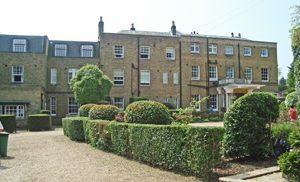
The northern elevation of the building at the second site in Thorpe, Surrey. The building was Grade II-listed in 1976.
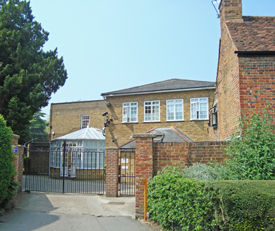
The eastern elevation.
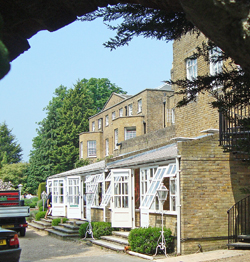
The southern elevation as seen from St Mary's Churchyard.

The wrought iron entrance gates, made in the early 18th century, are Grade II-listed.
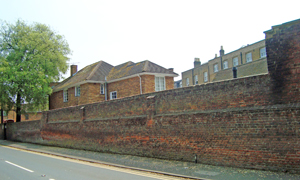
The brick wall along Coldharbour Lane.
(Author unstated) 1882 Intemperance in females. British Medical Journal 1 (1112), 590.
(Author unstated) 1890 Spelthorne Sanatorium. The Hospital, 19th July, 289.
(Author unstated) 1903 British Institutions for the Care of the Inebriate. The Hospital, 26th September, 457-158.
(Author unstated) 1914 The Medical Annual, 888.
(Author unstated) 1937 Sexual difficulties and alcohol. British Medical Journal 2 (3994), 180.
(Author unstated) 1989 Religious communities. The Door (November), 8-9.
(Author unstated) 2019 Proposed Additions to the Local List. 74, 85.
Alford SS 1880 Habitual Drunkards Act of 1879. London, H.K. Lewis.
Antrobus EE 1881 The Spelthorne Sanatorium (letter). British Medical Journal 1 (1060)l, 668.
Berridge V 1989 History and addiction control, The case of alcohol. In: Robinson D et al. (eds) Controlling Legal Addictions. London, Macmillan. 24-42.
Cameron AT 1918 The Religious Communities of the Church of England. London, Faith Press. 42-45.
Kerr N 1882 Retreat for dipsomaniacs (letter). British Medical Journal 1 (1104), 288.
Parliamentary Papers 1910 Report for the Inspector under the Inebriates Acts, 1879 to 1900, for the year 1908. London, H.M.S.O.
Sister Joan Elizabeth 1974 Helping Women Addicts at Spelthorne St Mary's, England. International Journal of Offender Therapy and Comparative Criminology 18, 77-81.
Sister Mildred Rebecca 1970 Nine decades of experience in the treatment of alcoholism and drug dependence. In: Phillipson RV (ed) Modern Trends in Drug Dependence and Alcoholism. London, Butterworths. 206-222.
http://edithsstreets.com
http://elvirabarney.wordpress.com
https://api.parliament.uk (1)
https://api.parliament.uk (2)
https://britishlistedbuildings.co.uk (1)
https://britishlistedbuildings.co.uk (2)
https://britishlistedbuildings.co.uk (3)
https://historicengland.org.uk
www.gettyimages.co.uk
www.harpenden-history.org.uk (1)
www.harpenden-history.org.uk (2)
www.victorianlondon.org
Return to home page